Epir Moloss

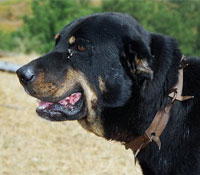 The legendary Molossos Tis Epirou is THE original dog of the ancient Molossian tribes of Greece, alongside the more famous Skilos Tou Pyrrou. Unlike the mild-mannered, even-tempered and light-coloured dogs of King Pyrros, the black-coated Polemistis Drakontas of Epirus is known for its fierce and ferocious personality, referred to as the "Dragon Warrior" or "Fighting Dragon" by its handlers and breeders. It is believed by some to had been developed by the Molossian warriors by crossing the Skilos tou Pyrrou with the wolf, while others are quick to point out that there are no black-n-tan wolves or other Greek dogs, suggesting that the colouring could instead be attributed to ancient Macedonian and Albanian scenthounds which may have played a role in its development as well.
The legendary Molossos Tis Epirou is THE original dog of the ancient Molossian tribes of Greece, alongside the more famous Skilos Tou Pyrrou. Unlike the mild-mannered, even-tempered and light-coloured dogs of King Pyrros, the black-coated Polemistis Drakontas of Epirus is known for its fierce and ferocious personality, referred to as the "Dragon Warrior" or "Fighting Dragon" by its handlers and breeders. It is believed by some to had been developed by the Molossian warriors by crossing the Skilos tou Pyrrou with the wolf, while others are quick to point out that there are no black-n-tan wolves or other Greek dogs, suggesting that the colouring could instead be attributed to ancient Macedonian and Albanian scenthounds which may have played a role in its development as well.
The breed's northern cousin, the Sylvan of Serbia is considered by many to in fact be the same breed and has also been suggested as a possible ancestor, although some believe that both breeds simply have roots in the same stock of dogs from Central Asia, rather than being two types of the same breed. Most likely, the Drakontas tis Epirou was developed through matings between Sylvans and the indigenous Hellenic Mastiff, a breed which is nearing extinction presently, but whose traces are still evident in the Molossos tis Epirou litters containing coat colours other than black or black-n-tan, as well as looser skin, greater amount of dewlap and shorter legs than usually associated with the true Molossian Dragons.
The Epirian Moloss could be classified into 2 basic types, with the traditional lighter and longer-legged variety being the primary one, while the shorter and heavier variant represents the variety from which many western mastiff breeds were developed. This is a typical rugged working mastiff, not unlike the Mastin Espanol and some other European dogs of the type. The Epir Moloss is also thought by some to be the ancestor of all black-n-tan breeds. While this is debatable, it is well known that Alexander the Great traveled with a number of dogs, including the mighty wardogs of Molossia. Through exposure to Rome, the Molossos tis Epirou influenced quite a few breeds, among them the ancestors of the Rottweiler and the Bernese Mountain Dogs, as well as the progenitors of what eventually became the foundation for the Neapolitan Mastiff. Alongside the aforementioned Serbian Dragon, the Mastino Espanol is believed by some to be the closest relative of this legendary Greek dog, evidenced by the obvious physical similarities and the solid black and black-n-tan coat colouring seen in some Spanish bloodlines.
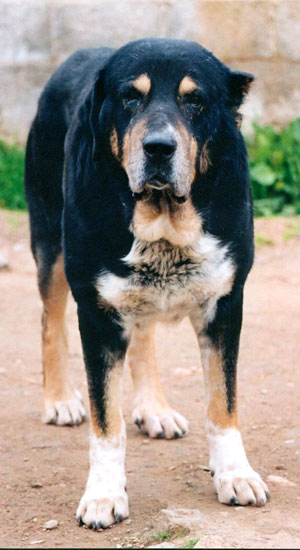
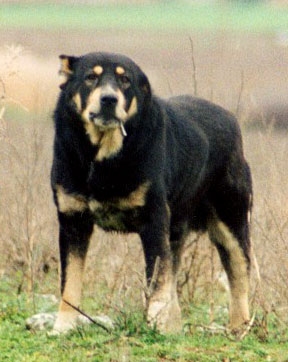 Like its relatives, the Skilos tou Pyrrou and Skilos tou Alexandrou, this resilient working breed is commonly lumped with other Greek shepherd dogs under the name Hellenikos Poimenikos, even though it differs greatly from them. Contrary to popular belief, Molossos tis Epirou is not extinct. Although the number of pure dogs has been rapidly diminishing over the years, there are still some specimens to be found in rural regions of North-Western Greece. Given the historical importance of this breed, it is only a matter of time before a serious revival programme is put into motion. Some fanciers believe that by the time the Molossian Shepherd receives proper attention and is finally taken seriously, it will be extinct. This attitude of the Epir Mastiff enthusiasts is due to their belief that other Greek revival programmes have been more successful because they're aimed at saving "nicer" breeds, such as the Ellinikos Poimenikos and the Skilos tou Pyrrou.
Like its relatives, the Skilos tou Pyrrou and Skilos tou Alexandrou, this resilient working breed is commonly lumped with other Greek shepherd dogs under the name Hellenikos Poimenikos, even though it differs greatly from them. Contrary to popular belief, Molossos tis Epirou is not extinct. Although the number of pure dogs has been rapidly diminishing over the years, there are still some specimens to be found in rural regions of North-Western Greece. Given the historical importance of this breed, it is only a matter of time before a serious revival programme is put into motion. Some fanciers believe that by the time the Molossian Shepherd receives proper attention and is finally taken seriously, it will be extinct. This attitude of the Epir Mastiff enthusiasts is due to their belief that other Greek revival programmes have been more successful because they're aimed at saving "nicer" breeds, such as the Ellinikos Poimenikos and the Skilos tou Pyrrou.
However, throughout the latter part of the last decade of the 20th century, rumours of the plans to recognize the Molossos tis Epirou have been reported, but there was a fear that the name will represent a separate "new" breed, which will not only consist of true Epirian Mastiffs, but will also number the Skilos tou Pyrrou and the Alexander's Dog as its representatives, as well as crosses between the three breeds. In 2006, that is exactly what had happened, the Molossos tis Epirou was finally accepted as an official breed in its native country, but this achievement, while immensely important and beneficial for the survival of the great Greek Molosser, was unfortunately "blemished" with the inclusion of the aforementioned two indigenous breeds as nothing more than colour varieties of the Epirian Mastiff instead of as true breeds on their own.
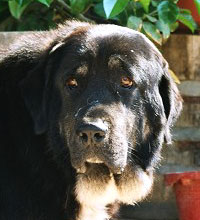
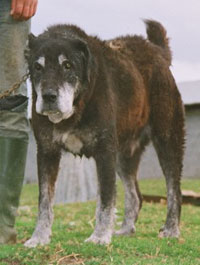 Used as a war dog, guardian and fighter in the past, the Molossos tis Epirou is today most commonly employed as a property watchdog and livestock protector. Very territorial, reasonably aggressive and quite independent, this powerful Molosser can be intolerant of strangers and needs firm handling and early socialization. However, this is also a trainable and intelligent breed, not vicious at all, but simply very protective when the need arises. One of the distinguishing characterictics of the Epir Moloss among other Greek breeds is its coat. Not only is it black or black-n-tan in colour, but the thick harsh coat is also noticeably shorter than usually found in mountain dogs and is described as having somewhat of a "goat hair" quality to the touch. A rare lighter sub-type of the Epir Mastiff has an even shorter coat and lighter build with somewhat "bully-esque" facial features, but some enthusiasts consider these dogs to constitute a separate breed. The true mountain type of the Epir Mastiff is a large-headed, wide-chested and broad-shouldered Moloss, with strong legs and a muscular body. The ears are oftentimes cropped and the tail can be either left natural or docked.
Used as a war dog, guardian and fighter in the past, the Molossos tis Epirou is today most commonly employed as a property watchdog and livestock protector. Very territorial, reasonably aggressive and quite independent, this powerful Molosser can be intolerant of strangers and needs firm handling and early socialization. However, this is also a trainable and intelligent breed, not vicious at all, but simply very protective when the need arises. One of the distinguishing characterictics of the Epir Moloss among other Greek breeds is its coat. Not only is it black or black-n-tan in colour, but the thick harsh coat is also noticeably shorter than usually found in mountain dogs and is described as having somewhat of a "goat hair" quality to the touch. A rare lighter sub-type of the Epir Mastiff has an even shorter coat and lighter build with somewhat "bully-esque" facial features, but some enthusiasts consider these dogs to constitute a separate breed. The true mountain type of the Epir Mastiff is a large-headed, wide-chested and broad-shouldered Moloss, with strong legs and a muscular body. The ears are oftentimes cropped and the tail can be either left natural or docked.
There are also some dark brown, brindle, reddish-fawn and tricoloured examples to be found, but these colourings aren't favoured by the breed purists, who maintain that only a clear black or black-n-tan dog can be a pure Molossos tis Epirou, while the others show greater influence of the aforementioned Hellenic Mastiff. Like the Sylvan, the Molossos tis Epirou can have a reddish-brown undercoat which is visible in the sunlight. There is some confusion on what the ideal height for the Epir Moloss should be, due to the great variety of sizes found today. There are dogs as small as 23 inches, as well as those that reach well over 32 inches at the withers.
